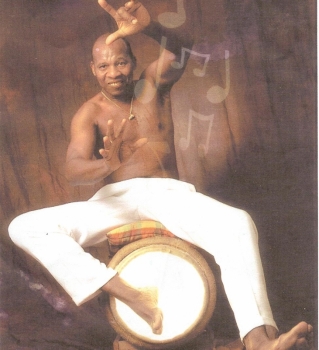Home >> Martinique >> Read about >> The drums of Africa get married to elegant court music from Paris
Guadeloupe
Martinique

The drums of Africa get married to elegant court music from Paris
No church Sanctus: drums were nothing other than the devil’s work in the eyes of the clergy. Nonetheless, the rhythm of the slaves from Africa found fertile ground on the French Caribbean islands. It blended with quadrilles, polkas and waltzes from Paris to create new Creole sounds with their own distinctive identities: bélé, gwo-ka and biguine are the counterparts to the reggae and calypso of the English-speaking islands.
By Bernhard Grdseloff
By Bernhard Grdseloff
In the old animism of the Africans, the drums provided a conduit to the gods. That alone was reason enough for the church to vilify the instrument as heathen. In Martinique and Guadeloupe though, plantation owners frequently turned a blind eye to them. "The slaves used rum barrels to build drums like the ones in their homeland," says Sully Cally, author of several books about the music of Martinique and Guadeloupe.
At first the tones were African: Martinique’s bélé and Guadeloupe’s gwo-ka are forms of call and response singing, with a chorister and the choir accompanied by drummers who sit astride their instruments. But the blacks were much more open-minded about the music of the whites than vice versa.
In Napoleon’s time – his wife Joséphine came from Martinique – Parisian court music came into vogue on the Caribbean islands. Creole musicians quickly took up quadrilles, polkas and waltzes. Sully Cally: "The music was Africanised; it didn’t have anything left in common with the original".
In the late nineteenth century, polka and bélé fused into a new style of music in Martinique: "biguine". Often accompanied by lyrics laden with political satire, the Creole mixture was a long-term success in the former island capital of Saint-Pierre. When the explosive eruption of the volcano Mt. Pelée destroyed the "Paris of the Caribbean" in 1902, claiming 28,000 victims, the Church was quick to place the blame: the "heathen music" was banned. Biguine was seldom heard again until the 1930s, when, together with the related New Orleans jazz, it experienced a renaissance...
Creole music styles: counterparts to Reggae and calypso
Bélé and gwo-ka: Narrative song accompanied by drums; call and response between a chorister and a choir. The original form of Creole music was played in various rhythms, to work to, for dancing or at wakes.
Da(n)myé: A martial dance, in which two opponents are urged on by the drums and the singing of a "commentator"..
Biguine: A cross between bélé and polka, played with trombone, clarinet and banjo. Later, the trumpet, saxophone, drums and other instruments were added, under the influence of New Orleans jazz.
Zouk: The newest phenomenon in Creole music, a favourite at dance parties. Developed in the 1980s, it is a mixture of biguine, the Creole mazurka, American pop music and other styles. The band "Kassav" brought it world fame.
At first the tones were African: Martinique’s bélé and Guadeloupe’s gwo-ka are forms of call and response singing, with a chorister and the choir accompanied by drummers who sit astride their instruments. But the blacks were much more open-minded about the music of the whites than vice versa.
In Napoleon’s time – his wife Joséphine came from Martinique – Parisian court music came into vogue on the Caribbean islands. Creole musicians quickly took up quadrilles, polkas and waltzes. Sully Cally: "The music was Africanised; it didn’t have anything left in common with the original".
In the late nineteenth century, polka and bélé fused into a new style of music in Martinique: "biguine". Often accompanied by lyrics laden with political satire, the Creole mixture was a long-term success in the former island capital of Saint-Pierre. When the explosive eruption of the volcano Mt. Pelée destroyed the "Paris of the Caribbean" in 1902, claiming 28,000 victims, the Church was quick to place the blame: the "heathen music" was banned. Biguine was seldom heard again until the 1930s, when, together with the related New Orleans jazz, it experienced a renaissance...
Creole music styles: counterparts to Reggae and calypso
Bélé and gwo-ka: Narrative song accompanied by drums; call and response between a chorister and a choir. The original form of Creole music was played in various rhythms, to work to, for dancing or at wakes.Da(n)myé: A martial dance, in which two opponents are urged on by the drums and the singing of a "commentator"..
Biguine: A cross between bélé and polka, played with trombone, clarinet and banjo. Later, the trumpet, saxophone, drums and other instruments were added, under the influence of New Orleans jazz.
Zouk: The newest phenomenon in Creole music, a favourite at dance parties. Developed in the 1980s, it is a mixture of biguine, the Creole mazurka, American pop music and other styles. The band "Kassav" brought it world fame.












